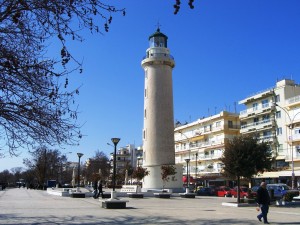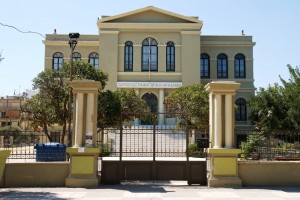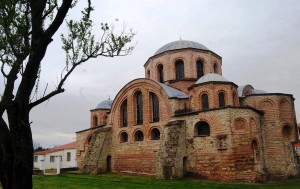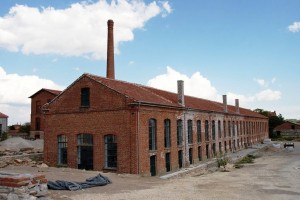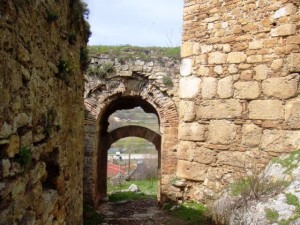Lighthouse of Alexandroupolis
The Lighthouse of Alexandroupolis was constructed by the French Lighthouse and Cresset Company and came in operation the first of June 1880. It is 27 m high and illuminates a 27 nautical miles distance leading ships safely into the port.
The need to build a lighthouse that would facilitate seamen toward the Ellispontos bay became apparent when a small port- where the port of Alexandroupoli stand today-started to be constructed in the 1850s. A cylinder stone tower with a wide base was built west of the port, on top of which a lighthouse was placed that would be very useful to coasting and sailing the high seas.
The lighthouse building is 18 meters high on ground level and 27 meters high from average sea level. Its signal is northern 40 50’ 07’’, and eastern 25’ 52’ 05’’.
The lighthouse flashes 3 white beams every 15 seconds.( 0,38 + 2,12 + 0,38 + 2,12 +0,38 + 9,62 =15δ). Its luminescence is 24 nautical miles and in good weather conditions it can be seen from a distance of 24 nautical miles (around 44 km).
It operates under supervision of the Lighthouse Service and it is one of the few supervised lighthouses left today. It is the nautical emblem of Alexandroupolis and during the celebration of Nautical Week in 1994 a marble plaque with its history was placed at the gate by the Antiquities and Cultural Heritage Club.
Zarifios Educational Academy of Alexandroupolis
The Zarifios Educational Academy is accommodated in a beautiful neo-classical building on the west side of the National Independence Park.
For more than half a century (1923-1947), it was the only institution of higher education.Both staff and students had a great cultural impact on the local people, and the teachers that were ‘’produced’’ from the academy passed their knowledge on to the whole of northern Greece. The Academy received donations from national benefactor Zarifis therefore it was named after him.
The figure of Georgios Zarifis is carved on a marble bust by the sculptor Perantinos and can be seen in the garden of the building that now houses the model schools of the Teaching Academy of the Dimokritos University of Thrace.
Panagia Kosmosotira (the People Savior) Holy Monastery – Feres
The story of the monastery in the Byzantine town Vira – now Feres, starts when the 6th child and third son of Alexios the 1ST Komninos and Irini Doukena, ‘’born in purple’’ Isaakiow Komninos was born ‘on the lips of river Evros’.
The monastery consists of a fortified enclosure (walls, towers and a gate) and a catholic constructed in the cruciform style of temples with two pillars and five domes. The frescoes that adorn the walls are fine examples of 12th century art of the Constantinople School. In the southeast corner of the temple there is an encompassed ceramic ornament with an eagle theme. We don’t know when the narthex was demolished, but the central arch and altar entrance have been repaired. The four external struts (beams) have been added later on.
The convent was founded in 1152 by Isaakios Komninos, third son of Alexios the first. Isaakios composed the convent’s ritual in which he was later buried. 200 years later, the catholic was converted into Souleiman’s mosque and 5, 5 centuries after, into a Christian church again. The catholic of the monastery is in operation today.
The north, east and south façade of the catholic have been restored. The drum of the dome was bound with a metal ring, the south pair of pillars was supported with steel plates and all the pillars were tightened with steel rings. The led roofing was repaired and some micro movements of the monument were tested using the invar measuring system. Moreover, conservation work was carried out in the fortification enclosure.
Byzantine Water Reservoir – Feres
Over the ancient river of Samias, just on the corner of the road that leads to Feres, you can make out the Byzantine reservoir that brought water from a source far away to the convent. The magnitude of the two arches, 5 meters high, 1,30 m wide and 7 meters space between them, is impressive. Built 800 years ago, with flint and bricks in the horizontal grooves, it was personally supervised by Isaakios Komninos himself.
This magnificent building takes on a whole different dimension in time and space, lit beautifully at night. The stone-carved arches can be seen from the road where it joints with the stream. The red bricks are colour-coordinated with the flint stones and the whole ensemble is quite imposing.
Tzivre Silk Factory in Soufli
The production and processing of the cocoons are developing rapidly with ever evolving new techniques. In the beginning of the 20th century organized production units are build and employ a considerable number of staff.
The main industrial complex was the silk factory of the Tzivre family and was built by Ceriano, an Italian, in 1910. The building facilities of the factory take up an area of 10.500 square meters.
It consists of 13 buildings, the most important being the three-storey warehouse for the cocoons, of total surface area 469 sm and volume 5.900 cubic m. Wooden bunk beds cover a surface of 2.915 s m. Other buildings of the production chain include the drier – the place where the cocoons are dried up in special furnaces-, the weaving mill, with 24 weaving webs and spinning mill and the main silk factory- where the raw material becomes silk threads- of total surface area 500 square meters.
The complex was bought by the council of Soufli who plan to restore and turn it into a technological museum and cultural centre.
The Kale Castle
You can make out the rocky silhouette from afar, as it is encompassed in great walls. The blocks – paved road starts in the main square, continues uphill through the traditional buildings and finally leads to the entrance of ‘Kale’. The tourist information kiosk is housed in an elegant wooden building, where the visitor can get information about the town history with video projections, tourist brochures and computer database.
The tour begins in a small square that resembles a theater gallery and ends to the peak of a round tower monogrammed with the name of Jesus, named ‘’Koulas tis Vasilopoulas’’ (the tower of the King’s daughter).
According to the legend, when the enemy took over the castle, the king’s daughter committed suicide by falling off the tower. A bit further down, we find the St Athanasius Metropolitan Church, an 1843 building, in the place of a Byzantine church. You can still see the remnants of this church on the north side. The wooden – carved iconostasis include icons dedicated by trade unions. A narrow street leads to the interior of the castle among old houses and it is like taking a stroll through the centuries.
The first stop is at a small chapel, a stone building that resembles a shrine, 2,5 meters long and 1,5 meters high. On the east side, a marble embossed icon of St. Demetrius reminds us of the Thracean Horseman. On the south side, four circles with crosses bear the inscription with the name of the Byzantine prince Raoul Asanis Palaiologos.
Every year the Didimoticho residents sacrificed roosters on St. Demetrious day, a custom dating back to early Christian times in honour of Asklipios. A bit higher up, covered by a high wall, we find the Armenian church of St. George. (Sourp Kevork). It is built where the Byzantine church of St. George Palaiokastritis used to be where on the 26th of October Ioannis Katakouzinos was crowned Emperor of the Romans (Byzantine state).
Didimoticho Great Mosque
A big, square construction made with well chiseled stones ad a pyramid-shaped roof instead of the traditional dome. The historical entrance is on the west side. The mosque was established during the era of Mohamed the first (1413-1421) close to the road Trainoupoli-Adrianoupoli. The led sheets of the roof have been replaced as well as the boarding, and the internal body has been restored using a metal tower. The frescoes have been cleaned up as well. Today it is used as a storing facility of antiquities found in the Didimoticho area.
Pythio Castle –Didimoticho
It is a fortified enclosure of the 14th century. It lies on a low mound of the eastern Rodopi mountain range and in front of the river Evros valley and constitutes a magnificent example of military architecture of the late Byzantine years. An external and internal part can still be seen today. The two main towers remain almost entirely intact. In the big square 4-storey tower that served as a house, we can see the eaves of the top floor, which was either not preserved or never actually built.
The smaller, also 4-storey tower had defensive military purposes. Between them, a big arched entrance led from the external to the internal enclosure, of which parts of the wall remain. The castle was built in the beginning of the 14th century and was used by the Byzantine emperor Ioannis the 6th Katakouzhnos as a refuge and personal ‘fund’. Towers of such structure are considered a Western influence on Byzantine military architecture.
.
For more information, vistit: www.visitevros.gr

